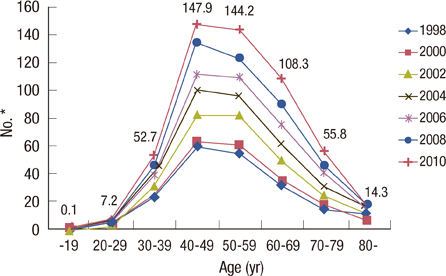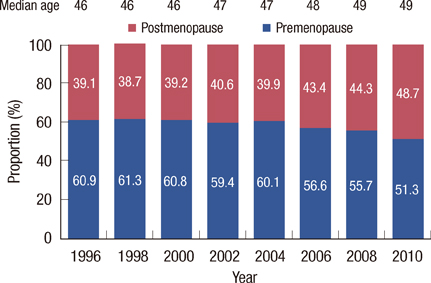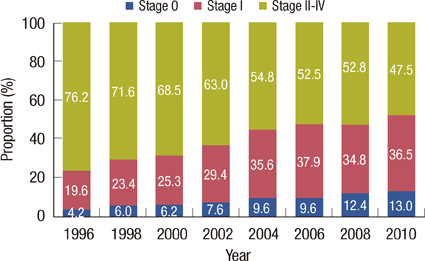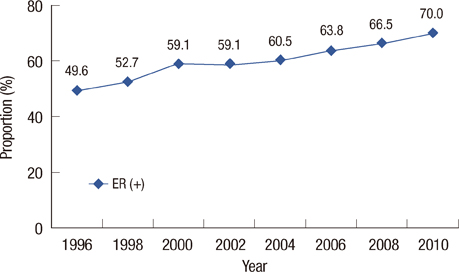Changing Patterns in the Clinical Characteristics of Korean Breast Cancer from 1996-2010 Using an Online Nationwide Breast Cancer Database
- Affiliations
-
- 1Department of Surgery, Center for Breast Cancer, Asan Medical Center, University of Ulsan College of Medicine, Seoul, Korea. ahnsh@amc.seoul.kr
- 2Department of Surgery, Korea Cancer Center Hospital, Seoul, Korea.
- 3Department of Surgery, Cheil General Hospital & Women's Healthcare Center, Kwandong University College of Medicine, Seoul, Korea.
- 4Department of Surgery, Yonsei University College of Medicine, Seoul, Korea.
- 5Breast Care Center, Seoul National University Bundang Hospital, Seongnam, Korea.
- 6Department of Surgery, Ewha Womans University Mokdong Hospital, Ewha Womans University School of Medicine, Seoul, Korea.
- 7Department of Surgery, Konkuk University School of Medicine, Seoul, Korea.
- KMID: 2286435
- DOI: http://doi.org/10.4048/jbc.2012.15.4.393
Abstract
- PURPOSE
Breast cancer is one of the most frequent malignancies in Korean women, and its incidence is increasing at a rapid rate. Since 1996, the Korean Breast Cancer Society has collected nationwide breast cancer data using an online registration program and analyzed the data biennial. The purpose of this study was to evaluate the characteristics of Korean breast cancer and to analyze changes in these characteristics over the period of time.
METHODS
Data were collected from 41 medical schools (74 hospitals), 24 general hospitals, and 6 private clinics. Data on the total number, gender, and age of newly-diagnosed breast cancer patients were collected through a questionnaire. Additional data were collected and analyzed from the online database.
RESULTS
In 2010, 16,398 patients in Korea were newly diagnosed with breast cancer. The crude incidence rate of female breast cancer was 67.2 cases per 100,000, and the median age at diagnosis was 49 years. The incidence of breast cancer was highest in patients aged between 40 and 49 years. Since 1996, there has been a significant increase in the proportion of early-stage cancers (detected in stage 1 or 2), the percentage of estrogen receptor-positive cancers, and in the proportion of patients receiving breast-conserving surgery.
CONCLUSION
The incidence and clinical characteristics of Korean breast cancer are slowly changing to the patterns of Western countries. To understand changing patterns in the characteristics of Korean breast cancer, the nationwide data should be continuously analyzed.
Keyword
MeSH Terms
Figure
Cited by 17 articles
-
Inhibition of tamoxifen's therapeutic effects by emodin in estrogen receptor-positive breast cancer cell lines
Yun Gyoung Kim, Yoon Hwa Park, Eun Yoel Yang, Won Seo Park, Kyoung Sik Park
Ann Surg Treat Res. 2019;97(5):230-238. doi: 10.4174/astr.2019.97.5.230.Updates on Cancer Epidemiology in Korea, 2018
Sun-Seog Kweon
Chonnam Med J. 2018;54(2):90-100. doi: 10.4068/cmj.2018.54.2.90.Characteristics and Survival of Breast Cancer Patients with Multiple Synchronous or Metachronous Primary Cancers
Janghee Lee, Seho Park, Sanghwa Kim, Jeeye Kim, Jegyu Ryu, Hyung Seok Park, Seung Il Kim, Byeong-Woo Park
Yonsei Med J. 2015;56(5):1213-1220. doi: 10.3349/ymj.2015.56.5.1213.The Clinical Utility of Automated Breast Volume Scanner: A Pilot Study of 139 Cases
Young Wook Kim, Seon Kwang Kim, Hyun Jo Youn, Eun Jung Choi, Sung Hoo Jung
J Breast Cancer. 2013;16(3):329-334. doi: 10.4048/jbc.2013.16.3.329.Validation of Risk Assessment Models for Predicting the Incidence of Breast Cancer in Korean Women
Jun Won Min, Myung-Chul Chang, Hae Kyung Lee, Min Hee Hur, Dong-Young Noh, Jung Han Yoon, Yongsik Jung, Jung-Hyun Yang,
J Breast Cancer. 2014;17(3):226-235. doi: 10.4048/jbc.2014.17.3.226.Meeting Highlights: The First Korean Breast Cancer Treatment Consensus Conference
Airi Han, Kyoung Eun Lee, Hae Kyung Lee, Yeon Hee Park, Jeryoung Kim, Sung-Won Kim, Kyung Hae Jung, Byung-Ho Son,
J Breast Cancer. 2014;17(4):308-313. doi: 10.4048/jbc.2014.17.4.308.The Basic Facts of Korean Breast Cancer in 2011: Results of a Nationwide Survey and Breast Cancer Registry Database
Zisun Kim, Sun Young Min, Chan Seok Yoon, Hun Jae Lee, Jung Sun Lee, Hyun Jo Youn, Heung Kyu Park, Dong-Young Noh, Min Hee Hur,
J Breast Cancer. 2014;17(2):99-106. doi: 10.4048/jbc.2014.17.2.99.The Basic Facts of Korean Breast Cancer in 2012: Results from a Nationwide Survey and Breast Cancer Registry Database
Zisun Kim, Sun Young Min, Chan Seok Yoon, Kyu-Won Jung, Beom Seok Ko, Eunyoung Kang, Seok Jin Nam, Seokwon Lee, Min Hee Hur,
J Breast Cancer. 2015;18(2):103-111. doi: 10.4048/jbc.2015.18.2.103.Comparison of Clinicopathological Features and Treatment Results between Invasive Lobular Carcinoma and Ductal Carcinoma of the Breast
Jun Su Park, Doo Ho Choi, Seung Jae Huh, Won Park, Young Il Kim, Seok Jin Nam, Jeong Eon Lee, Won Ho Kil
J Breast Cancer. 2015;18(3):285-290. doi: 10.4048/jbc.2015.18.3.285.Survival Improvement in Korean Breast Cancer Patients Due to Increases in Early-Stage Cancers and Hormone Receptor Positive/HER2 Negative Subtypes: A Nationwide Registry-Based Study
Jee Man You, Yun Gyoung Kim, Hyeong-Gon Moon, Seok Jin Nam, Jong Won Lee, Woosung Lim, Mi-Ri Lee, Dong-Young Noh, Wonshik Han
J Breast Cancer. 2015;18(1):8-15. doi: 10.4048/jbc.2015.18.1.8.The Basic Facts of Korean Breast Cancer in 2013: Results of a Nationwide Survey and Breast Cancer Registry Database
Sun Young Min, Zisun Kim, Min Hee Hur, Chan Seok Yoon, Eun-Hwa Park, Kyu-Won Jung,
J Breast Cancer. 2016;19(1):1-7. doi: 10.4048/jbc.2016.19.1.1.Basic Facts of Breast Cancer in Korea in 2014: The 10-Year Overall Survival Progress
Eun Hwa Park, Sun Young Min, Zisun Kim, Chan Seok Yoon, Kyu-Won Jung, Seok Jin Nam, Se Jeong Oh, Seeyoun Lee, Byeong-Woo Park, Woosung Lim, Min Hee Hur,
J Breast Cancer. 2017;20(1):1-11. doi: 10.4048/jbc.2017.20.1.1.Clinicopathologic Characteristics of Pregnancy-Associated Breast Cancer: Results of Analysis of a Nationwide Breast Cancer Registry Database
Yun Gyoung Kim, Ye Won Jeon, Byung Kyun Ko, Guiyun Sohn, Eun-Kyu Kim, Byung-In Moon, Hyun Jo Youn, Hyun-Ah Kim,
J Breast Cancer. 2017;20(3):264-269. doi: 10.4048/jbc.2017.20.3.264.Comparison of clinicopathological characteristics and prognosis in breast cancer patients with different Breast Imaging Reporting and Data System categories
Bong Kyun Kim, Jai Min Ryu, Se Jeong Oh, Jaihong Han, Jung Eun Choi, Joon Jeong, Young Jin Suh, Jina Lee, Woo Young Sun,
Ann Surg Treat Res. 2021;101(3):131-139. doi: 10.4174/astr.2021.101.3.131.Clinicopathological characteristics of
BRCA -associated breast cancer in Asian patients
Eun-Kyu Kim, So Yeon Park, Sung-Won Kim
J Pathol Transl Med. 2020;54(4):265-275. doi: 10.4132/jptm.2020.04.07.Survival Outcome of Combined GnRH Agonist and Tamoxifen Is Comparable to That of Sequential Adriamycin and Cyclophosphamide Chemotherapy Plus Tamoxifen in Premenopausal Patients with Lymph-Node–Negative, Hormone-Responsive, HER2-Negative, T1-T2 Breast Cancer
Guiyun Sohn, Sei Hyun Ahn, Hee Jeong Kim, Byung-Ho Son, Jong Won Lee, Beom Seok Ko, Yura Lee, Sae Byul Lee, Seunghee Baek
Cancer Res Treat. 2016;48(4):1351-1362. doi: 10.4143/crt.2015.444.No Association of Positive Superficial and/or Deep Margins with Local Recurrence in Invasive Breast Cancer Treated with Breast-Conserving Surgery
Tae In Yoon, Jong Won Lee, Sae Byul Lee, Guiyun Sohn, Jisun Kim, Il Young Chung, Hee Jeong Kim, Beom Seok Ko, Byung Ho Son, Gyungyub Gong, Sung-Bae Kim, Su Ssan Kim, Seung Do Ahn, Minsung Chung, Sei Hyun Ahn
Cancer Res Treat. 2018;50(1):275-282. doi: 10.4143/crt.2017.041.
Reference
-
1. Jemal A, Bray F, Center MM, Ferlay J, Ward E, Forman D. Global cancer statistics. CA Cancer J Clin. 2011. 61:69–90.
Article2. Forouzanfar MH, Foreman KJ, Delossantos AM, Lozano R, Lopez AD, Murray CJ, et al. Breast and cervical cancer in 187 countries between 1980 and 2010: a systematic analysis. Lancet. 2011. 378:1461–1484.
Article3. Siegel R, Naishadham D, Jemal A. Cancer statistics, 2012. CA Cancer J Clin. 2012. 62:10–29.
Article4. Shin HR, Joubert C, Boniol M, Hery C, Ahn SH, Won YJ, et al. Recent trends and patterns in breast cancer incidence among Eastern and Southeastern Asian women. Cancer Causes Control. 2010. 21:1777–1785.
Article5. National Cancer Center. Report on the Statistics for National Cancer Incidence 2009. 2011. Goyang: National Cancer Center.6. Korean Breast Cancer Society. Korean breast cancer data of 1996. J Korean Surg Soc. 1998. 55:621–635.7. Korean Breast Cancer Society. Korean breast cancer data of 1997. J Korean Cancer Assoc. 1999. 31:1202–1209.8. Korean Breast Cancer Society. Clinical characteristics of breast cancer patients in Korea in year 2000. J Korean Breast Cancer Soc. 2002. 5:217–224.9. The Korean Breast Cancer Society. Nationwide Korean breast cancer data of 2004 using breast cancer registration program. J Breast Cancer. 2006. 9:151–161.10. Ahn SH, Yoo KY. Korean Breast Cancer Society. Chronological changes of clinical characteristics in 31,115 new breast cancer patients among Koreans during 1996-2004. Breast Cancer Res Treat. 2006. 99:209–214.
Article11. Ko SS. Korean Breast Cancer Society. Chronological changing patterns of clinical characteristics of Korean breast cancer patients during 10 years (1996-2006) using nationwide breast cancer registration on-line program: biannual update. J Surg Oncol. 2008. 98:318–323.
Article12. Jung YS, Na KY, Kim KS, Ahn SH, Lee SJ, Park HK, et al. Nation-wide Korean breast cancer data from 2008 using the breast cancer registration program. J Breast Cancer. 2011. 14:229–236.
Article13. Leong SP, Shen ZZ, Liu TJ, Agarwal G, Tajima T, Paik NS, et al. Is breast cancer the same disease in Asian and Western countries? World J Surg. 2010. 34:2308–2324.
Article14. National Cancer Center. Report on the Statistics for National Cancer Incidence 1999-2009. 2012. Goyang: National Cancer Center.15. National Cancer Institute. SEER cancer statistics review, 1975-2009. Accessed October 31st, 2012. http://seer.cancer.gov/csr/1975_2009_pops09/index.html.16. Lambe M, Wigertz A, Holmqvist M, Adolfsson J, Bardage C, Fornander T, et al. Reductions in use of hormone replacement therapy: effects on Swedish breast cancer incidence trends only seen after several years. Breast Cancer Res Treat. 2010. 121:679–683.
Article17. Autier P, Hery C, Haukka J, Boniol M, Byrnes G. Advanced breast cancer and breast cancer mortality in randomized controlled trials on mammography screening. J Clin Oncol. 2009. 27:5919–5923.
Article18. Saji S, Hiraoka M, Tokuda Y, Fukui N, Ikeda T. Trends in local therapy application for early breast cancer patients in the Japanese Breast Cancer Society Breast Cancer Registry during 2004-2009. Breast Cancer. 2012. 19:1–3.
Article19. Habermann EB, Abbott A, Parsons HM, Virnig BA, Al-Refaie WB, Tuttle TM. Are mastectomy rates really increasing in the United States? J Clin Oncol. 2010. 28:3437–3441.
Article20. DeSantis C, Howlader N, Cronin KA, Jemal A. Breast cancer incidence rates in U.S. women are no longer declining. Cancer Epidemiol Biomarkers Prev. 2011. 20:733–739.
Article21. Yamashita H, Iwase H, Toyama T, Takahashi S, Sugiura H, Yoshimoto N, et al. Estrogen receptor-positive breast cancer in Japanese women: trends in incidence, characteristics, and prognosis. Ann Oncol. 2011. 22:1318–1325.
Article22. Devi CR, Tang TS, Corbex M. Incidence and risk factors for breast cancer subtypes in three distinct South-East Asian ethnic groups: Chinese, Malay and natives of Sarawak, Malaysia. Int J Cancer. 2012. 131:2869–2877.
Article23. Yip CH, Pathy NB, Uiterwaal CS, Taib NA, Tan GH, Mun KS, et al. Factors affecting estrogen receptor status in a multiracial Asian country: an analysis of 3557 cases. Breast. 2011. 20:Suppl 2. S60–S64.
Article24. Anderson WF, Katki HA, Rosenberg PS. Incidence of breast cancer in the United States: current and future trends. J Natl Cancer Inst. 2011. 103:1397–1402.
Article
- Full Text Links
- Actions
-
Cited
- CITED
-
- Close
- Share
- Similar articles
-
- The Basic Facts of Korean Breast Cancer in 2011: Results of a Nationwide Survey and Breast Cancer Registry Database
- The Basic Facts of Korean Breast Cancer in 2012: Results from a Nationwide Survey and Breast Cancer Registry Database
- Nationwide Korean Breast Cancer Data of 2002 The Korean Breast Cancer Society
- The Basic Facts of Korean Breast Cancer in 2013: Results of a Nationwide Survey and Breast Cancer Registry Database
- Nationwide Korean Breast Cancer Data of 2004 Using Breast Cancer Registration Program









